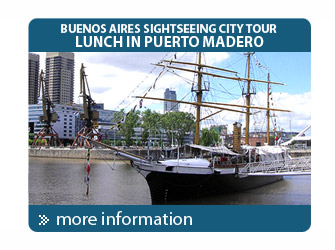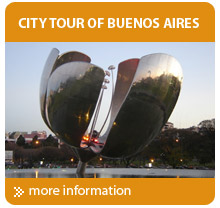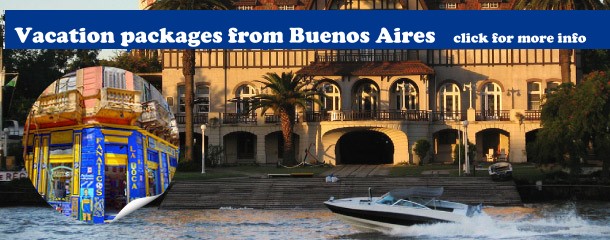Buenos Aires tour in its historical and modern buildings
Today in this article we offer a tour of the most emblematic buildings of Buenos Aires.
Around the Plaza de Mayo, there are some of the most important historical buildings: the Casa Rosada, it is the government house since 1862, the Cathedral, which dates from 1852, the Cabildo, whose facade was rebuilt similar to 1810 and the National Bank, which is one of the largest domes in the world. Since the beginning of the city, around the square always was concentrated all the political, religious and economic activity of the nation. The Plaza de Mayo is also place of celebration and protest. The meeting place of the Argentines. On the balcony of the Casa Rosada, Evita rallied the «shirtless», marching through the square since 1977 the mothers and grandmothers of the disappeared in the last military dictatorship (1976-1983) and there are also different sectors of society expressing their grievances. Not the most beautiful, but the most symbolically significant for Argentines.
The Avenida de Mayo joins: the Casa Rosada in Plaza de Mayo and the National Congress. In its path there are theaters, cafes, monuments and landmarks of the city, around which have passed the most important historical events of the country. It is worth pausing at the House of Culture (former newspaper La Prensa) where you can see much of the heritage of the early nineteenth century, with outstanding works of art, badges and flags (Saturdays from 16-17 and Sunday 11-16), the famous «The 36 Billiards» “Palacio Barolo” and «Tortoni coffe», where artists like Quinquela Martin, Jorge Luis Borges and Roberto Arlt passed there.
La plaza San Martin is the main green space in the neighborhood of Retiro. A walk through this area of Retiro clearly expresses the Parisian character adopted by Buenos Aires in the early twentieth century, due to their construction and landscaping. They placed the most distinguished family’s palatial residences. An example is the former Hotel Plaza (now Marriot). Also facing the square is born Florida pedestrian Street, on which there are found at the height of Córdoba Avenue the Pacific Galleries, imposing building remodeled as a commercial center today.
At the intersection of Avenida Alvear and Carlos Pellegrini avenue there are two embassies, worth seeing, that of Brazil and France, both of French style. Later, following Libertador avenue towards the area of the Faculty of Law (Doric style ), and in the Recoleta neighborhood, stands the Palacio Errazuriz-Alvear, the Museum of Decorative Arts. In this same area are concentrated the National Museum of Fine Arts, the Palais de Glace, originally opened as a skating rink, and the Centro Cultural Recoleta. Next to the center, stands the Basilica of Our Lady of Pilar dating from 1720.
 Following the tour, we got to the magical neighborhood of San Telmo, with its ancient buildings, cobbled streets and lanterns. Old mansions converted into galleries coexist with local antiques, design shops, bars, cafés and restaurants. Plaza Dorrego is the second oldest city and every Sunday has a large antique market. On Balcarce street, stand three important buildings: the Church of San Pedro Telmo, the Prison Museum and School Rawson. More near the Freeway May 25, are on Passage of Defense and the Museum of Modern Art in Buenos Aires. Venezuela on the street is the home to 400 of the Viceroy Liniers, one of the oldest buildings still standing, it is possible to attend between 12 and 18hrs. And in Venezuela at 200, the National College Classic.
Following the tour, we got to the magical neighborhood of San Telmo, with its ancient buildings, cobbled streets and lanterns. Old mansions converted into galleries coexist with local antiques, design shops, bars, cafés and restaurants. Plaza Dorrego is the second oldest city and every Sunday has a large antique market. On Balcarce street, stand three important buildings: the Church of San Pedro Telmo, the Prison Museum and School Rawson. More near the Freeway May 25, are on Passage of Defense and the Museum of Modern Art in Buenos Aires. Venezuela on the street is the home to 400 of the Viceroy Liniers, one of the oldest buildings still standing, it is possible to attend between 12 and 18hrs. And in Venezuela at 200, the National College Classic.
 Already in La Boca, a water’s edge of the Riachuelo, predominantly tin houses, canteens and Italian museums like Bellas Artes de La Boca «Quinquela Martin» and the recently extended Fundación Proa. It is one of the most picturesque neighborhoods of Buenos Aires. The nineteenth-century Italian immigration gave character to this neighborhood where more than half of the population was foreign. The families of immigrants lived in tenements. They built their home in metal and wood, on stilts, and stained with leftover paint from the shipyards. The color is a distinctive feature that is maintained until today.
Already in La Boca, a water’s edge of the Riachuelo, predominantly tin houses, canteens and Italian museums like Bellas Artes de La Boca «Quinquela Martin» and the recently extended Fundación Proa. It is one of the most picturesque neighborhoods of Buenos Aires. The nineteenth-century Italian immigration gave character to this neighborhood where more than half of the population was foreign. The families of immigrants lived in tenements. They built their home in metal and wood, on stilts, and stained with leftover paint from the shipyards. The color is a distinctive feature that is maintained until today.
Meanwhile, in Puerto Madero there is a series of buildings to admire as the Malecón building a 12-floor tower built in 1999 or Porteño Mill, opened in 1891, a true icon of the functional architecture port. It is the most modern neighborhood in Buenos Aires and combines luxury glass towers, cultural spaces, green oases, places for nightlife and exquisite cuisine. Accommodations are all top notches and are a magnet for high-end tourism.
The list continues and becomes infinite, but this is a good choice to start walking and see more or booking a city tour with 01Argentina Travel Agency.



